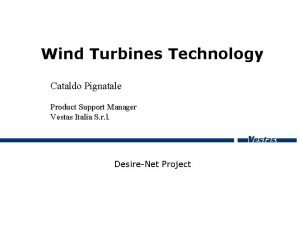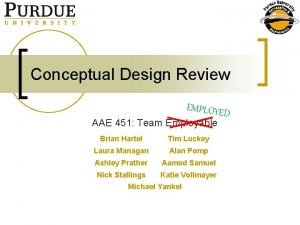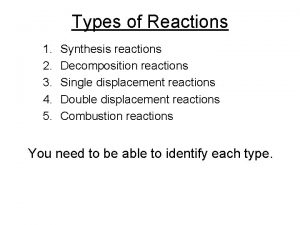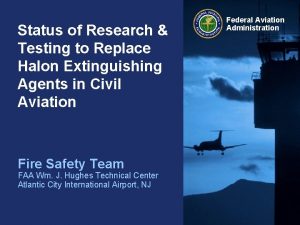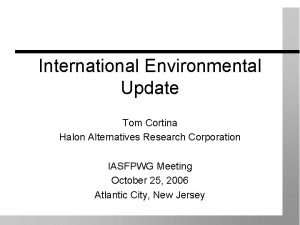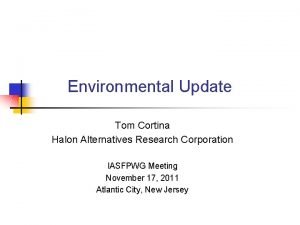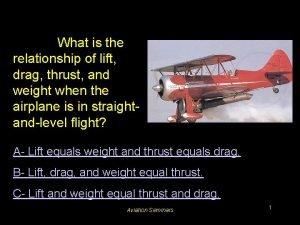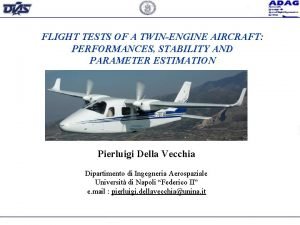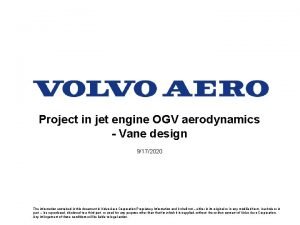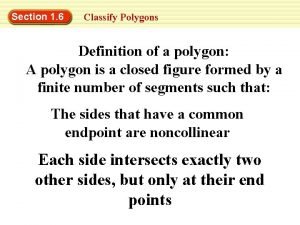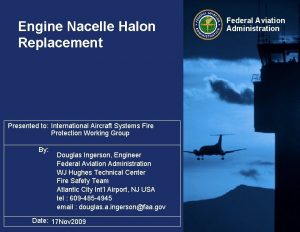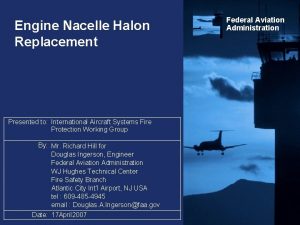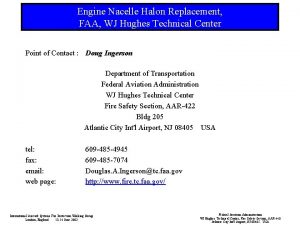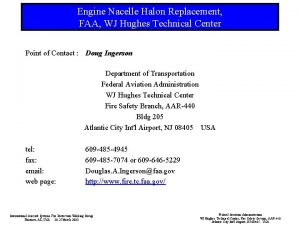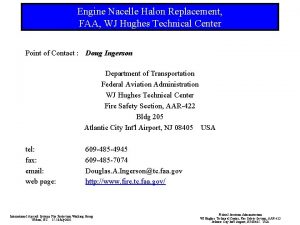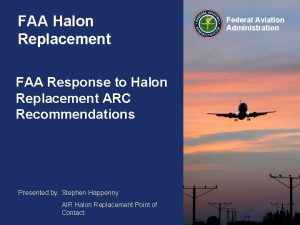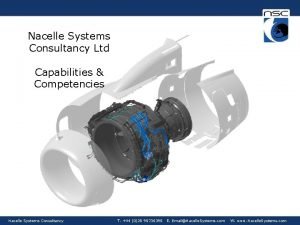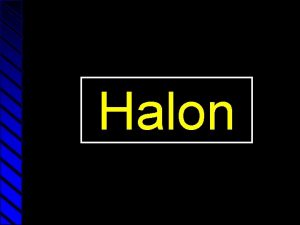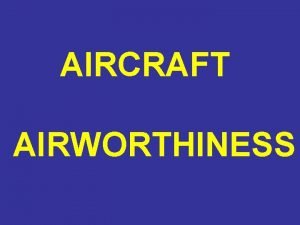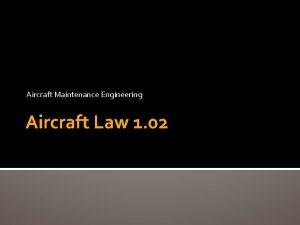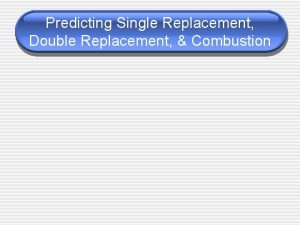Engine Nacelle Halon Replacement Presented to International Aircraft

















- Slides: 17

Engine Nacelle Halon Replacement Presented to: International Aircraft Systems Fire Protection Working Group By: Mr. Richard Hill for Douglas Ingerson, Engineer Federal Aviation Administration WJ Hughes Technical Center Fire Safety Branch Atlantic City Int’l Airport, NJ USA tel : 609 -485 -4945 email : Douglas. A. Ingerson@faa. gov Date: 17 April 2007 Federal Aviation Administration

Presentation Overview • Review Equivalent Concentrations for HFC-125, CF 3 I, and FK-5 -1 -12 • Alterations/Embellishments to the Minimum Performance Standard for Engine Nacelles and APU Compartments (MPSe) – Move away from a Halon 1301 Benchmark – Considerations for atypical fire extinguishing agents IASFP Working Group Meeting, London, England 16 -17 April 2007 Federal Aviation Administration 2 2

Equivalent Concentrations, HFC-125, CF 3 I, FK-5 -1 -12 • Based on work completed in the FAA Technical Center’s nacelle fire simulator in accordance with the MPSe • Calculated values exceed cup burner data and intermingle with inerting data IASFP Working Group Meeting, London, England 16 -17 April 2007 Federal Aviation Administration 3 3

Equivalent Concentrations, HFC-125, CF 3 I, FK-5 -1 -12 IASFP Working Group Meeting, London, England 16 -17 April 2007 Federal Aviation Administration 4 4

Alterations to the MPSe Move the MPSe off a Halon 1301 Benchmark • Why ? – Halon 1301 supplies diminishing – continued discharge to atmosphere SPECIFIED for testing purposes – need to move forward • How ? – specify another fire extinguishing agent as the benchmark – specify the combustion threats – other ? IASFP Working Group Meeting, London, England 16 -17 April 2007 Federal Aviation Administration 5 5

Alterations to the MPSe Move the MPSe off a Halon 1301 Benchmark • Specify another fire extinguishing agent as the benchmark – HFC-125 • Pro’s – compares physically to Halon 1301 better than common choices – established work with this agent already exists within aviation – widely used outside aviation as a halon replacement candidate • Con’s – global warmer – increased mass required to equate to Halon 1301 performance – CF 3 I : no forecasted use by working group members; currently not considered a possibility for this issue IASFP Working Group Meeting, London, England 16 -17 April 2007 Federal Aviation Administration 6 6

Alterations to the MPSe Move the MPSe off a Halon 1301 Benchmark • Specify another fire extinguishing agent as the benchmark (continued) – FK-5 -1 -12 • Pro’s – not a global warmer – wide use as a halon replacement being established outside aviation • Con’s – physically dissimilar to Halon 1301 – increased mass required to equate to Halon 1301 performance – lesser work established within aviation – other suggestion ? IASFP Working Group Meeting, London, England 16 -17 April 2007 Federal Aviation Administration 7 7

Alterations to the MPSe Move the MPSe off a Halon 1301 Benchmark • Specify the combustion threats – During early developmental history of the MPSe, task group opted NOT to do this • complex test environment; i. e. aerodynamically dependent, flame holding, electrical arcs, hot surfaces, ignition behaviors, fuel/air diffusion behavior, etc. • observed/measured the fire extinction performance of Halon 1301 and forced a candidate to replicate the established performance – fire threat intensity affirmed by delivering “half-certification” Halon 1301 and verifying no fire extinction – negated specifying by heat flux, temperature profile, geometries, fuel flows, etc. IASFP Working Group Meeting, London, England 16 -17 April 2007 Federal Aviation Administration 8 8

Alterations to the MPSe Move the MPSe off a Halon 1301 Benchmark • Specify the combustion threats (continued) – HOWEVER, this offers another path to remove the specification of Halon 1301 from the MPSe • need to specify : – – fuel types, initial fuel temperature, flow rates, fuel spray patterns, etc. energy release of the fire threat; i. e. heat flux, temperature geometries of the fire threat; i. e. flame holders, hot surface(s) ventilated pathway of the structure • some of this specification already exists in the MPSe • principle focus for additional thought/work/specification are the fire threats themselves IASFP Working Group Meeting, London, England 16 -17 April 2007 Federal Aviation Administration 9 9

Alterations to the MPSe Move the MPSe off a Halon 1301 Benchmark • Other possibilities to remove the Halon 1301 benchmark ? IASFP Working Group Meeting, London, England 16 -17 April 2007 Federal Aviation Administration 10 10

Alterations to the MPSe Considerations for atypical replacement candidates • MPSe is written with sections reserved to allow for atypical replacement candidates • These sections are currently unspecified • Potential examples : – agents delivered as liquid or solid aerosols; i. e. particles – active or inert gas generators; i. e. gases and particles – hybrids; clean agents sitting atop an inert gas generator IASFP Working Group Meeting, London, England 16 -17 April 2007 Federal Aviation Administration 11 11

Alterations to the MPSe Considerations for atypical replacement candidates • Current state of the art for civil aviation is clean, gaseous agents • The entire certification process is dependent upon the current state of the art • Atypical candidates will require alternate means of measurement to demonstrate acceptable behavior IASFP Working Group Meeting, London, England 16 -17 April 2007 Federal Aviation Administration 12 12

Alterations to the MPSe Considerations for atypical replacement candidates • How should atypical agent quantification be handled in the MPSe ? – Statham-derivative gas analyzers are written into the MPSe due to common availability and historical stature – no means to measure aerosols is recognized by the FAA – no means to measure products from inert gas generators is recognized by the FAA • two major decomposition products are H 2 O(g) and N 2 • Statham-derivative analyzers : – can not measure N 2 concentration – have no history of measuring water vapor » early reports indicate sensitivity to atmospheric humidity » however, potentially insufficient sensitivity IASFP Working Group Meeting, London, England 16 -17 April 2007 Federal Aviation Administration 13 13

Alterations to the MPSe Considerations for atypical replacement candidates • How should atypical agent quantification be handled in the MPSe ? (continued) – if an applicant pursues an atypical agent pathway : • they will be required, by default, to develop/prove their own measurement method and equipment • what is the impact on the MPSe as a result ? – incorporate new words in the reserved sections about the atypical agent and measurement procedure; in essence, specify agent and applicant in the MPSe – remove details from the MPSe regarding the Statham-derivative analyzers and their applicability to clean agents » by doing so, negates the need to specify atypical agent details » could place ambiguous wording to ensure an adequate measurement process is followed IASFP Working Group Meeting, London, England 16 -17 April 2007 Federal Aviation Administration 14 14

Alterations to the MPSe Considerations for atypical replacement candidates • Impact on the assessment of the reignition time delay (RTD) – RTD = time (fire reignition) – time (fire extinction) • agent pulse moves through ventilated test fixture • persistent fuel and ignition sources force reignition after agent pulse degrades sufficiently – due to the use of clean agents, the RTD is a reasonably visiual determination from video tape; is specified so in the MPSe – atypical agents may obscure visibility • change the specification in the MPSe to permit alternate means ? • should the specification change be “tight”/exact or ambiguous ? IASFP Working Group Meeting, London, England 16 -17 April 2007 Federal Aviation Administration 15 15

Alterations to the MPSe Considerations for atypical replacement candidates • Impact on the assessment of the reignition time delay (RTD) (continued) – historical work indicates the use of a fine-bead thermocouple is inexact as compared to visual indication • thermal response too slow • thermocouple bead location is very important – alternate considerations • track energy output from the obscured volume surrounding the flame – obscured cloud temperature should change obviously based on the lack or presence of energy (flames) internal to the cloud – absorption/reflection/transmission characteristics of the cloud are likely unknowns • use a Gardon gage style heat flux transducer • other ? IASFP Working Group Meeting, London, England 16 -17 April 2007 Federal Aviation Administration 16 16

Concluding Summary • Equivalent concentrations – HFC-125 = 17. 6%v/v – CF 3 I = 7. 1%v/v – FK-5 -1 -12 = 6. 1%v/v • Engine task group members please consider impacts to the MPSe due to : – replacing the Halon 1301 benchmark with another reference – atypical Halon 1301 replacement agents : • whether or not to specify individual analytical measurement methods • how to asses the RTD by non-visual means – comments to be solicited in the “near” future IASFP Working Group Meeting, London, England 16 -17 April 2007 Federal Aviation Administration 17 17
 Nacelle
Nacelle Nacelle chevrons
Nacelle chevrons Combustion reaction equation
Combustion reaction equation Haloni za gasenje pozara
Haloni za gasenje pozara Tom halon
Tom halon Xtase montreal
Xtase montreal Tom halon
Tom halon Detonation occurs in a reciprocating aircraft engine when
Detonation occurs in a reciprocating aircraft engine when Twin engine aircraft
Twin engine aircraft Ogv engine
Ogv engine Aircraft engine placement
Aircraft engine placement Internal combustion engine vs external combustion engine
Internal combustion engine vs external combustion engine Presented sy
Presented sy Kicker headline examples
Kicker headline examples Macbeth act v scene v
Macbeth act v scene v The technological design model is presented as a
The technological design model is presented as a Name of presenter
Name of presenter Identify the following polygons
Identify the following polygons
